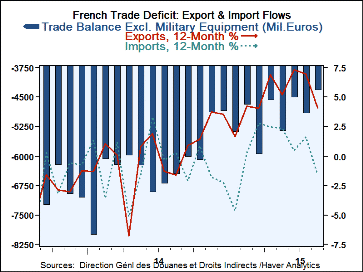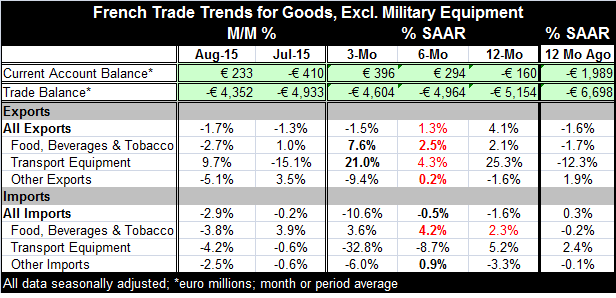 Global| Oct 12 2015
Global| Oct 12 2015France Shows Trade Flow Reversal
Summary
French trade flows have turned sharply weaker in August as exports fell by 1.7% and imports dropped by 2.9%. The relatively sharper weakness in imports thrust the current account into surplus (0.2 billion euros). Sequential growth [...]
 French trade flows have turned sharply weaker in August as exports fell by 1.7% and imports dropped by 2.9%. The relatively sharper weakness in imports thrust the current account into surplus (0.2 billion euros). Sequential growth rates show both exports and imports on a track for accelerating weakness. Export growth is on a relatively flat profile with growth deteriorating from a pace of 4.1% over 12 months to 1.3% over six months and -1.5% over three months. Imports show -1.6% over 12 months with slight `speed-up' to -0.5% over six months before deteriorating sharply by dropping at a -10.6% annualized pace over three months.
French trade flows have turned sharply weaker in August as exports fell by 1.7% and imports dropped by 2.9%. The relatively sharper weakness in imports thrust the current account into surplus (0.2 billion euros). Sequential growth rates show both exports and imports on a track for accelerating weakness. Export growth is on a relatively flat profile with growth deteriorating from a pace of 4.1% over 12 months to 1.3% over six months and -1.5% over three months. Imports show -1.6% over 12 months with slight `speed-up' to -0.5% over six months before deteriorating sharply by dropping at a -10.6% annualized pace over three months.
French exports of transportation equipment and food buck the slowdown trend with sharply stronger growth over three months for each flow. However, other exports drop sharply over three months.
Imports show deteriorating trends and imports decline over three months for transportation and other imports while food imports buck the slowdown trend.
Moreover, both exports and imports are slowing sharply. That is suggestive of a slowdown in growth. Are French export markets slowing that much and is domestic demand in the French economy slowing sharply as well?
Both of France's Markit PMIs, for manufacturing and for services, are above the value of 50 for the first time in three months: that is a constructive configuration for growth. Industrial output is lower (y/y) in only two of the last eight months. Consumer and business confidence seem to be in good shape: the Insee gauges of business and household confidence are both moving higher. French motor vehicle registrations are strong. Meanwhile, French inflation is still weak with a year-over-year headline gain of just 0.1%. On balance, French economic indicators do not seem anywhere near as weak as French imports are. Perhaps imports are simply undergoing some erratic movements? But French exports are confirming the signs of global weakness we have been seeing in Germany, Europe's most competitive economy. Germany has demonstrated declines in exports and orders and its industrial output fell, all last month. It is still a very difficult global environment. And that means it is good to be wary and not to dismiss signs of weakness when they emerge. Weakness has been spreading.

Robert Brusca
AuthorMore in Author Profile »Robert A. Brusca is Chief Economist of Fact and Opinion Economics, a consulting firm he founded in Manhattan. He has been an economist on Wall Street for over 25 years. He has visited central banking and large institutional clients in over 30 countries in his career as an economist. Mr. Brusca was a Divisional Research Chief at the Federal Reserve Bank of NY (Chief of the International Financial markets Division), a Fed Watcher at Irving Trust and Chief Economist at Nikko Securities International. He is widely quoted and appears in various media. Mr. Brusca holds an MA and Ph.D. in economics from Michigan State University and a BA in Economics from the University of Michigan. His research pursues his strong interests in non aligned policy economics as well as international economics. FAO Economics’ research targets investors to assist them in making better investment decisions in stocks, bonds and in a variety of international assets. The company does not manage money and has no conflicts in giving economic advice.






